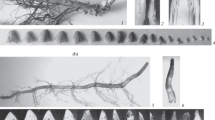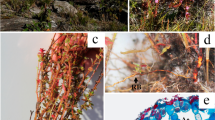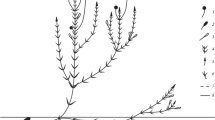Abstract
The role of dormant buds in the formation and transformation of herbaceous life forms of plants was determined by the example of a number of species of the genus Nepeta. Different variants of shoot formation and mechanisms reorganization of biomorphs with the participation of dormant buds are described. It has been established that regular and irregular development of dormant buds may lead to the formation of shortened, remote-nodal, and elongated residue, which are the basis for the construction of new shoot structures (shoot systems and rooting partial formations) typical for long-rhizome biomorphs.


Similar content being viewed by others
REFERENCES
Aaron, I., Dormant and adventitious buds, Science, 1946, vol. 104.
Astashenkov, A.Yu. and Cheryomushkina, V.A., Arkhitekturnaya model’ Nepeta mariae (Lamiaceae), Rast. Mir Aziat. Rossii, 2016, no. 4 (24), pp. 22–29.
Astashenkov, A.Yu., Cheryomushkina, V.A., Grebenjuk, A.V., and Dzumanov, S.D., Transformation of life forms and ontogenetic structure of Nepeta pulchella Pojark. coenopopulations in Aksy-Zhabaglinsky Nature Reserve, Contemp. Probl. Ecol., 2017, vol. 10, no. 6, pp. 758–771.
Baldini, E. and Mosse, B., Observations on the origin and development of spheroblasts in the apple, J. Hortic. Sci., 1956, vol. 31, pp. 156–162.
Barthélémy, D. and Caraglio, Y., Plant architecture: a dynamic, multilevel and comprehensive approach to plant form, structure and ontogeny, Ann. Bot., 2007, no. 99 (3), pp. 375–407.
Basargin, E.A., Biomorphology of some long-rhizome plant species and the structure of their coenopopulations in southern Siberia, Cand. Sci. (Biol.) Dissertation, Novosibirsk, 2011.
Borisova, I.V., Biology and basic life forms of perennial herbaceous dicots of steppe phytocenoses of northern Kazakhstan, Tr. Bot. Inst. Akad. Nauk SSSR, Ser. 3: Geobotanika, Moscow: Nauka, 1961, no. 13, pp. 54–132.
Budantsev, A.L., Taxonomy of the genus Nepeta (Lamiaceae). Species of section Spicatae, Bot. Zh., 1990, vol. 75, no. 7, pp. 1004–1013.
Büsgen, M., Bau und Leben unserer Waldbäume Illus, Jena, 1897.
Chandler, W., Fruit Growing, Cambridge: Riverside Press, 1925, pp. 14–19.
Cheryomushkina, V.A., Biologiya lukov Evrazii (Biology of Onions of Eurasia), Novosibirsk: Nauka, 2004.
Cheryomushkina, V.A., Features of ontogenesis of short-rhizome plants, in Materialy Mezhdunarodnoi nauchnoi konferentsii, posvyashchennoi 80-letiyu Instituta botaniki i fitointroduktsii “Rastitel’nyi mir i ego okhrana,” g. Almaty, 5–7 sentyabrya 2012 goda (Proc. Int. Sci. Conf. Dedicated to the 80th Anniversary of the Institute of Botany “The Flora and Its Protection,” Almaty, September 5–7, 2012), Almaty: LEM, 2012, pp. 396–398.
Cheryomushkina, V.A. and Guseva, A.A., Life forms of Scutellaria supina L. (Lamiaceae), Contemp. Probl. Ecol., 2015, vol. 8, no. 5, pp. 624–635.
Cheryomushkina, V.A., Astashenkov, A.Yu., Guseva, A.A., and Denisova, G.R., Characteristics of Lagochilus ilicifolius (Lamiaceae) in the boundary populations of Tuva, Rast. Resur., 2016, vol. 52, no. 3, pp. 381–396.
Esser, P., Die Entstehung der Blüten am alten Holze, Verh. Nat. Hist. Verein., Bonn:Jahrg, 1887, vol. 44, no. 4, pp. 69–112.
Gatsuk, L.E., Methods for the description and determination of life forms in a seasonal climate, Byull. Mosk. O-va Ispyt. Prir., Otd.Biol., 1974, vol. 79, no. 3, pp. 84–100.
Gatsuk, L.E., Derviz-Sokolova, T.G., Ivanova, I.V., and Shafranova, L.M., Pathways of transition from shrubby to herbaceous forms in some taxa of angiosperms, in Problemy filogenii vysshikh rastenii (Problems of Phylogeny of Higher Plants), Moscow: Nauka, 1974, pp. 16–36.
Getmanets, I.A., Morphoadaptive determination of structural diversity of biomorphs of Salix L. species in Southern Urals, Contemp. Probl. Ecol., 2015, vol. 8, no. 5, pp. 574–583.
Goebel, K., Organographie der Pflanzenzen, insbesondere der Archegoniaten und Samenpflanzen, Aufl. 3, Teil. 1, Jena: Fisher, 1928.
Haberlandt, G., Eine botanische Tropenreise, Aufl. 3, Leipzig: Endelmann, 1926.
Hallé, F. and Oldeman, R.A.A., Essai sur l architecture et la dynamique de croissance des arbres tropicaux, Paris: Masson, 1970.
Hallé, F., Oldeman, R.A.A., and Tomlinson, P.B., Tropical Trees and Forests, Berlin: Springer, 1978.
Hartig, Th., Vollständige Naturgeschichte der Forstlichen Culturpflanzen Deutschlands, Berlin: A. Förstner’sche Verlagsbuchhandlung, 1851.
Jost, L., Über schlafende Knospen, Flora, 1925, vols. 118/119, pp. 289–299.
Karnaukhova, N.A., Ontogenesis and life forms of Hedysarum (Fabaceae) in south Siberia, Contemp. Probl. Ecol., 2015, vol. 8, no. 5, pp. 614–623.
Khokhryakov, A.P., Evolyutsiya biomorf rastenii (Evolution of Plant Biomorphs), Moscow: Nauka, 1981.
Khutornoi, O.V., Velisevich, S.N., and Vorob’ev, V.N., Ecological variation in the morphological structure of the crown in Siberian stone pine at the timberline, Russ. J. Ecol., 2001, vol. 32, no. 6, pp. 393–399.
Kochkareva, T.F., Family Lamiaceae, in Flora TadzhSSR (Flora of Tajik SSR), Leningrad: Nauka, 1986, vol. 8, pp. 104–142.
Kostina, M.V., Barabanshikova, N.S., Bityugova, G.V., Yasinskaya, O.I., and Dubach, A.M., Structural modifications of birch (Betula pendula Roth.) crown in relation to environmental conditions, Contemp. Probl. Ecol., 2015, vol. 8, no. 5, pp. 584–597.
Kozhevnikov, A.V., Vesna i osen’ v zhizni rastenii (Spring and Autumn in the Life of Plants), Moscow: Mosk. o-vo ispyt. prir., 1950.
Lyashenko, N.I., On dormant buds of shrubs, Bot. Zh., 1958, vol. 43, no. 7, pp. 1039–1047.
Lyashenko, N.I., Biologiya spyashchikh pochek (Biology of Dormant Buds), Moscow: Nauka, 1964.
Lyubarskii, E.L., Ekologiya vegetativnogo razmnozheniya vysshikh rastenii (Ecology of Vegetative Propagation of Higher Plants), Kazan: Kazan. Gos. Univ., 1967.
Lyubimenko, V.N., On dormant buds, Tr. St.-Petersburg. O-va Estestvoispyt.,Otd. Bot., 1900, vol. 30, no. 3, pp. 195–259.
Marfenin, N.N., The concept of modular organization in development, Zh. Obshch. Biol., 1999, vol. 60, no. 1, pp. 6–17.
Mazurenko, M.T., Biomorfologicheskie adaptatsii rastenii Krainego Severa (Biomorphological Adaptation of Plants of the Far North), Moscow: Nauka, 1986.
Mazurenko, M.T. and Khokhryakov, A.P., Struktura i morfogenez kustarnikov (Structure and Morphogenesis of Shrubs), Moscow: Nauka, 1977.
Měch, R. and Prusinkiewicz, P., Visual models of plants interacting with their environment, in Computer Graphics Proceedings, Annual Conference Series, ACM SIGGRAPH, New Orleans, Louisiana: ASSN for Computing Machinery, 1996, pp. 367–410.
Meusel, H., Uber Wuchsformen, Verbreitung und Phylogenie einiger mediterranmitteleuropaischen Angiospermen—Gattungen, Flora, 1953, vol. 139, no. 3, pp. 333–393.
Millet, J., Bouchard, A., and Ѐdelin, C., Plagiotropic architectural development of four tree species of the temperate forest, Can. J. Bot., 1998, vol. 76, no. 12, pp. 2100–2118.
Nikolini, E., Chanson, B., and Bonne, F., Stem growth and epicormic branch formation in understorey beech trees (Fagus sylvatica L.), Ann. Bot., 2001, vol. 87, pp. 737–750.
Notov, A.A., On the specifics of the functional organization and the individual development of modular objects, Zh. Obshch. Biol., 1999, vol. 60, no. 1, pp. 60–79.
Nukhimovskii, E.L., Osnovy biomorfologii vysshikh rastenii (Basics of Biomorphology of Higher Plants), Moscow: Nedra, 1997, vol. 1.
Osmanova, G.O., Morfologicheskie osobennosti osobei i struktura tsenopopulyatsii Plantago lanceolata L. (Morphological Features of Individual Plants and the Structure of Coenopopulations of Plantago lanceolata L.), Yoshkar-Ola: Mar. Gos. Univ., 2007.
Ping Li and Dohnston, M.O., Heterochrony in plant evolutionary studies through the twentieth century, Bot. Rev., 2000, vol. 66, pp. 57–88.
Poyarkova, A.I., New catnip species, Bot. Mat. Gerb. Bot. Inst. Akad. Nauk SSSR, 1953, vol. 15, pp. 282–320.
Poyarkova, A.I., Family Lamiaceae, in Flora SSSR (Flora of the USSR), Moscow: Nauka, 1954, vol. 20, pp. 286–360.
Rabotnov, T.A., Life cycle of perennial herbaceous plants in the meadow coenoses, Tr. Bot. Inst. Akad. Nauk SSSR, Ser. 3: Geobotanika, Moscow: Nauka, 1950.
Sabatier, S. and Barthélémy, D., Bud structure in relation to shoot morphology and position on the vegetative annual shoots of Juglans regia L. (Juglandaceae), Ann. Bot., 2001, vol. 87, pp. 117–123.
Savinykh, N.P., Architecture of herbs, in Materialy II Vserossiiskoi shkoly-seminara “Aktual’nye problemy sovremennoi biomorfologii” (Proc. II All-Russia School–Workshop “Actual Problems of Modern Biomorphology”), Kirov: Raduga-Pres, 2012, pp. 342–354.
Serebryakov, I.G., Morfologiya vegetativnykh organov vysshikh rastenii (The Morphology of the Vegetative Organs of Higher Plants), Moscow: Nauka, 1952.
Serebryakov, I.G., Biological–morphological and phylogenetic analysis of life forms of angiosperms, Uch. Zap. Mosk. Gos. Pedagog. Inst.im.V.P. Potemkina, 1954, vol. 37, no. 2, pp. 21–89.
Serebryakov, I.G., The main directions in the evolution of life forms in angiosperms, Byull. Mosk. O-va Ispyt. Prir., Otd.Biol., 1955, vol. 60, no. 3, pp. 71–91.
Serebryakov, I.G., The dormant period in some herbaceous and woody plants of Moscow environs, Uch. Zap. Mosk. Gos. Pedagog. Inst.im.V.P. Potemkina, 1959, vol. 100, no. 5, pp. 39–51.
Serebryakov, I.G., Ekologicheskaya morfologiya rastenii (Ecological Plant Morphology), Moscow: Vysshaya Shkola, 1962.
Serebryakova, T.I., On the main “architectural models” of herbaceous perennials and modes of their transformation, Byull. Mosk. O-va Ispyt. Prir., Otd.Biol., 1977, vol. 82, no. 5, pp. 112–128.
Serebryakova, T.I. and Petukhova, L.V., “Architectural model” and life forms of some herbaceous plants, Byull. Mosk. O-va Ispyt. Prir., Otd.Biol., 1978, vol. 83, no. 6, pp. 51–64.
Serebryakova, T.I., Once again, on the concept of the “life form” in plants, Byull. Mosk. O-va Ispyt. Prir., Otd.Biol., 1980, vol. 85, no. 6, pp. 75–86.
Serebryakova, T.I., Bud as a stage of shoot development, in VII Soveshchanie Vsesoyuznogo botanicheskogo obshchestva, Tezisy dokladov (Proc. VII All-Union. Conf. Bot. Soc., Abstracts of Papers), Leningrad: Nauka, 1983.
Shafranova, L.M., Some pathways of transition from shrubs to herbs in the genus Potentilla L., Extended Abstract of Cand. Sci. (Biol.) Dissertation, Moscow: Mosk. Gos. Pedagog. Inst., 1970.
Shafranova, L.M. and Gattsuk, L.E., Plant as a spatiotemporal metameric (modular) system, in Uspekhi ekologicheskoi morfologii rastenii (Advances in Ecological Plant Morphology), Moscow: Prometei, 1994, pp. 6–7.
Smirnova, O.V., Struktura travyanistogo pokrova shirokolistvennykh lesov (The Structure of the Herbaceous Cover of Deciduous Forests), Moscow: Nauka, 1987.
Smirnova, O.V., Zaugol’nova, L.B., Toropova, N.A., and Falikov, L.D., Criteria for distinguishing age states and the features of the course of ontogeny in plants of different biomorphs, in Tsenopopulyatsii rastenii (Coenopopulations of Plants), Moscow: Nauka, 1976, pp. 14–44.
Smirnova, O.V., Chistyakova, A.A., and Istomina, I.I., Quasi-senility as one of the manifestations of phytocenotic plant tolerance, Zh. Obshch. Biol., 1984, vol. 45, no. 2, pp. 216–225.
Söding, G., Rostovye veshchestva rastenii (Plant Growth Substances), Moscow: Izd. Inostr. Lit., 1955.
Steshenko, A.P., Formation of the structure of semishrubs in the high mountains of the Pamirs, Tr. Bot. Inst. Akad. Nauk TadzhSSR, 1956.
Uranov, A.A., The age spectrum of phytocoenopopulations as a function of time and energy wave processes, in Nauchnye Doklady Vysshei Shkoly, Biologisheskie Nauki (Scientific Reports of the Higher School, Biological Sciences), Moscow: Nauka, 1975, no. 2, pp. 7–34.
Velenovsky, J., Vergleichende Morphologie der Pflanzen, Praga: Rivnac, 1905, vol. 1.
Vodolazova, S.V., Cheryomushkina, V.A., Kolegova, E.B., and Myadelets, M.A., Ontogenesis, coenopopulation structure, and ecological-coenotic characteristics of Nepeta sibirica (Lamiaceae) in Khakassia, Rast. Resur., 2010, vol. 46, no. 1, pp. 3–16.
Zhukova, L.A., Populyatsionnaya zhizn’ lugovykh rastenii (Population Life of Meadow Plants), Yoshkar-Ola: Lanar, 1995.
Author information
Authors and Affiliations
Corresponding author
Ethics declarations
The authors declare that they have no conflict of interest. This article does not contain any studies involving animals or human participants performed by any of the authors.
Additional information
Translated by T. Borisova
Rights and permissions
About this article
Cite this article
Astashenkov, A.Y., Cheryomushkina, V.A. The Role of Dormant Buds in Transformation of Herbaceous Biomorphs (by the Example of Nepeta L. sect. Spicatae (Benth.) Pojark.). Biol Bull Russ Acad Sci 46, 562–569 (2019). https://doi.org/10.1134/S1062359019040046
Received:
Revised:
Accepted:
Published:
Issue Date:
DOI: https://doi.org/10.1134/S1062359019040046




